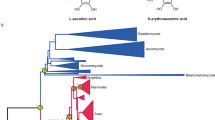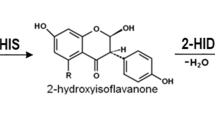Abstract
IN plants and animals hydroxyproline hydroxyl oxygen is derived from the direct fixation of molecular oxygen1–4. It was therefore reasonable to propose that the mechanism of this oxygen fixation was analogous to those steroid hydroxylations which involve displacement of a single proton with retention of configuration5–8. One way of testing this proposal appeared to be opened by the availability of 3–4 tritiated proline. Determination of the tritium lost during hydroxylation should indicate the number of protons displaced. Two groups of workers have recently published the results of their experiments with 3–4 3H proline9–12.
This is a preview of subscription content, access via your institution
Access options
Subscribe to this journal
Receive 51 print issues and online access
$199.00 per year
only $3.90 per issue
Buy this article
- Purchase on Springer Link
- Instant access to full article PDF
Prices may be subject to local taxes which are calculated during checkout
Similar content being viewed by others
References
Fujimoto, D., and Tamiya, N., Biochem. J., 84, 333 (1962).
Fujimoto, D., and Tamiya, N., Biochim. Biophys. Acta, 69, 559 (1963).
Prockop, D., Kaplan, A., and Udenfriend, S., Biochem. Biophys. Res. Comm., 9, 162 (1962).
Lamport, D. T. A., J. Biol. Chem., 238, 1438 (1963).
Hayano, M., Gut, M., Dorfman, R. I., Sebek, O. K., and Peterson, D. H., J. Amer. Chem. Soc., 80, 2336 (1958).
Bergstrom, S., Lindstredt, S., Samuelson, B., Corey, E. J., and Gregoriou, G. A., J. Amer. Chem. Soc., 80, 2337 (1958).
Corey, E. J., Gregoriou, G. A., and Peterson, D. H., J. Amer. Chem. Soc., 80, 2338 (1958).
Ingraham, L. L., in Biochemical Mechanisms (John Wiley and Sons, Inc., New York, 1962).
Stone, N., and Meister, A., Nature, 194, 555 (1962).
Stone, N., and Meister, A., Fed. Proc., 21, 414 (1962).
Meister, A., Stone, N., and Manning, J. M., Paper presented at the American Chemical Society Meeting in Atlantic City, September, 1962, Abstr. 37.
Ebert, P. S., and Prockop, D., Biochem. Biophys. Res. Comm., 8, 305 (1962).
Lamport, D. T. A., Fed. Proc., 22, 647 (1963).
Chvapil, M., and Hurych, J., Nature, 184, 1145 (1959).
Breslow, R., and Lukens, L. N., J. Biol. Chem., 235, 292 (1960).
Ratner, S., Rittenberg, D., and Schoenheimer, R., J. Biol. Ckem., 135, 357 (1940).
Author information
Authors and Affiliations
Rights and permissions
About this article
Cite this article
LAMPORT, D. Hydroxyproline Biosynthesis : Loss of Hydrogen during the Hydroxylation of Proline. Nature 202, 293–294 (1964). https://doi.org/10.1038/202293a0
Issue Date:
DOI: https://doi.org/10.1038/202293a0
This article is cited by
Comments
By submitting a comment you agree to abide by our Terms and Community Guidelines. If you find something abusive or that does not comply with our terms or guidelines please flag it as inappropriate.



